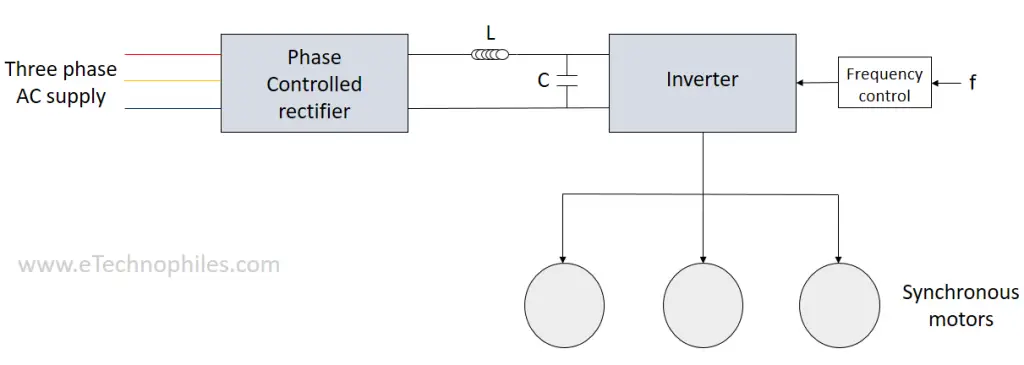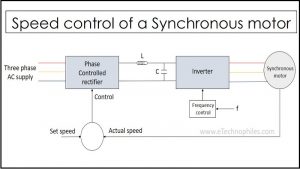Last updated on March 23rd, 2024 at 04:02 pm
A Synchronous motor is a type of AC motor that runs at a constant speed. And before discussing the speed control methods of a Synchronous motor, let us see how to find the speed of a synchronous motor.
Using this simple formula: Ns = (120xf) / p , we can calculate the synchronous speed of any synchronous motor.
Let’s look at this formula in more detail.
Table of Contents
What is Ns=(120xf)/p all about?
Ns here stands for synchronous motor speed and as evident by the formula, it depends on two factors:
Frequency (f)
We know that an AC supply system has a particular frequency. The frequency indicates the number of times the rotating magnetic field rotates inside the armature. In the US, this frequency is 60Hz, while in India / UK, this frequency is 50 Hz. So, the (f) in the formula represents the frequency of the AC supply connected to the synchronous motor.
Number of stator poles (p)

Every AC motor consists of a Stator (the stationary part of the motor). The inner periphery of the stator contains slots for the windings. So, according to the winding distribution inside these slots, we can create the desired number of Stator poles. The (p) in the formula represents the number of stator poles.
So, from the formula given above, it is clear that we can achieve the speed control of synchronous motor by either of the two methods:
- Changing the number of Stator poles
- Changing the frequency of AC supply
Why do we require speed control of synchronous motor?
We know that a Synchronous motor is a constant-speed motor. Its speed does not alter despite the load variations. So, why do we need speed control of synchronous motor?
It is because some industries prefer Synchronous motors over induction motors for speed control. Synchronous motors are more efficient and have fewer losses than induction motors. So, using them improves reliability.
What parameters can we vary for speed control of synchronous motor?
After designing an AC motor, it is difficult to change the speed by changing the stator poles. To make it happen, for every speed variation that we require, we have to open the motor and rearrange the windings to modify the number of Stator poles. This method doesn’t look practical, agree? So, the only option that remains is to vary the frequency of incoming AC supply to control the motor speed.
To vary the frequency, we use a combination of rectifiers and inverters and use them in either of the following modes:
- Separate control or Open loop mode
- Self-control or Closed-loop mode
Let us first look at how to use them in an Open-loop mode.
Separate control or open loop mode
This method uses an open-loop system that does not have any feedback. The following figure shows the block diagram of the separate control synchronous motor system.

Working
A rectifier unit first converts the Alternating current to pulsating Direct current. The inductor and capacitor in the circuit act as a filter and refine the DC waveform.
We can easily set the new frequency for the AC waveform using the frequency circuit. The inverter uses the Pulse Width Modulation (PWM) technique to convert the DC to AC. The AC obtained now has a different frequency as compared to the original AC supply.
Hence in this way, we can vary the frequency to control the speed of the synchronous motor.
Drawbacks
As said earlier, this is an open-loop system, i.e., once we set the frequency in the circuit, the system does not know about the output condition. If somehow the speed of the motors changes, the system can’t take any actions to regulate the speed of the motors. Thus, to reduce the chances of speed error, we require a better speed control method.
Applications
- This method finds applications where slight changes in motor speed do not vary the load connected to the motor.
- The open-loop control is a suitable way to control parallel-connected synchronous motors. By setting the frequency in the circuit, the speed of all the motors changes simultaneously.
Self-control or closed-loop mode

The closed-loop method uses a feedback system to monitor the speed of the motor. The following figure shows the block diagram of the closed-loop speed control system.
Working
The working procedure of this system is similar to the above-discussed method. Here also, we can easily vary the frequency of the output AC wave using the frequency circuit.
But here, a sensor continuously monitors the rotor speed. An error detector compares the preset speed and the actual speed of the rotor and sends the difference value to the rectifier circuit. The rectifier circuit suitably adjusts the firing angle to control the magnitude of the output DC wave. Thus, this method reduces the chances of speed error and is more reliable than the open-loop speed control method.
Applications
- We use the closed-loop speed control method where accurate speed control is required.
- This method is suitable for large gearless drives, viz. mine hoists, drives for mills, etc.
Conclusion
Let us quickly conclude the main points of the speed control of the synchronous motor discussed in our article.
- We can achieve the speed control of synchronous motor either by changing the number of Stator poles or changing the frequency of AC supply.
- Varying the frequency is a feasible way for speed control of the synchronous motor.
- Using the rectifier and inverter combination, we can vary the frequency of AC supply.
- There are two methods to vary the frequency of AC supply: Separate control (Open-loop control) and Self-control (Closed-loop control).
- The Separate control method does not use feedback, and the chances of speed error are more.
- The Self-control method uses a feedback sensor to monitor the rotor speed. The chances of error get reduced in this method.
- The closed-loop method is preferred over the open-loop method for precise speed control of the synchronous motor.
